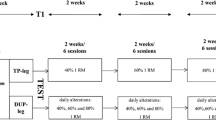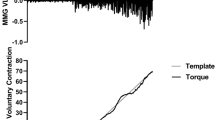Abstract
Purpose
We examined differences between trained males and females in measures of muscular fatigability and central motor output after a resistance exercise session.
Methods
Sixteen trained males (n = 8) and females (n = 8) participated in the study. Knee extensor maximal torque and rate of torque development were measured before and after the exercise session, and the twitch interpolation technique was used during the maximal efforts to derive measures of voluntary activation and muscle contractility by supramaximal stimulation of the femoral nerve using 10 and 100 Hz doublets. Surface electromyograms were recorded during all maximal efforts to examine maximal and rate of quadriceps muscle activation.
Results
After exercise, maximal torque was reduced for both sexes by 26.3 ± 12.5% (p < 0.001). Absolute and relative vRTD was reduced only for males after exercise (p < 0.05). The early (0–50 ms) rate of muscle activation rise was similarly reduced for both sexes between 2.6 and 16.4% s−1 (p < 0.01), but males experienced an average decrease of 82.5 ± 72.1% s−1 for the maximal rate of muscle activation compared to no change for females (p = 0.02). Males had greater reductions (p < 0.05) for maximal twitch amplitudes and rate of twitch development (− 51.1 ± 21.5% and − 49.9 ± 22.8%, respectively) compared to females (− 35.8 ± 13.7% and − 31.5 ± 14.0%, respectively).
Conclusions
These findings suggest that trained females are resistant to reductions in rapid torque development, despite similar reductions in maximal torque, after resistance exercise, with this result explained by better-maintained muscle contractility and maximal rate of muscle activation compared to males.



Similar content being viewed by others
Abbreviations
- 1-RM:
-
1-repetition maximum strength test
- ½ RT:
-
Half relaxation time
- ANOVA:
-
Analysis of variance
- β :
-
Beta, representing the estimate for type II experimental error
- BW:
-
Bodyweight
- d :
-
Cohen’s effect size
- MVC:
-
Maximal voluntary isometric contraction
- MVT:
-
Maximal voluntary torque
- M-wave:
-
Muscle compound action potential
- RER:
-
Rate of EMG rise
- sEMG:
-
Surface electromyogram
- TPT:
-
Time to peak twitch
- VA:
-
Voluntary activation
- VL:
-
Vastus lateralis
- VM:
-
Vastus medialis
- vRTD:
-
Voluntary rate of torque development
References
Aargaard P, Simonsen EB, Andersen JL, Magnusson P, Dyhre-Poulsen P (2002) Increased rate of force development and neural drive of human skeletal muscle following resistance training. J Appl Physiol 93:1318–1326. https://doi.org/10.1152/japplphysio.00283.2002
Behm DG, St-Pierre DMM, Perez D (1996) Muscle inactivation: assessment of interpolated twitch technique. J Appl Physiol 81:2267–2273. https://doi.org/10.1152/jappl.1996.81.5.2267
Button DC, Behm DG (2008) The effect of stimulus anticipation on the interpolated twitch technique. J Sports Sci Med 7:520–524
Carroll TJ, Riek S, Carson RG (2002) The sites of neural adaptation induced by resistance training in humans. J Physiol 544:641–652. https://doi.org/10.1113/jphysiol.2002.024463
Ekblom MMN (2010) Improvements in dynamic plantar flexor strength after resistance training are associated with increased voluntary activation and V-to-M ratio. J Appl Physiol 109:19–26. https://doi.org/10.1152/japplphysiol.01307.2009
Erdfelder E, Faul F, Buchner A (1996) GPOWER: a general power analysis program. Behav Res Methods Instrum Comput 28:1–11
Fitts RH (2003) Effects of regular exercise training on skeletal muscle contractile function. Am J Phys Med Rehabil 82:320–331. https://doi.org/10.1097/01.PHM.0000059336.40487.9C
Harridge SDR, Bottinelli R, Canepari M, Pelllegrino MA, Reggiani C, Esbjörnsson M, Saltin B (1996) Whole-muscle and single-fibre contractile properties and myosin heavy chain isoforms in humans. Pflüg Arch 432:913–920
Hodges PW, Bui BH (1996) A comparison of computer-based methods for the determination of onset of muscle contraction using electromyography. Electroencephalogr Clin Neurophysiol/Electromyogr 101(6):511–519
Hunter SK (2014) Sex differences in human fatigability: mechanisms and insight to physiological responses. Acta Physiol 210:768–789. https://doi.org/10.1111/alpha.12234
Hunter SK, Enoka RM (2001) Sex differences in the fatigability of arm muscles depends on absolute force during isometric contractions. J Appl Physiol 91:2686–2694. https://doi.org/10.1152/jappl.2001.91.6.2686
Hunter SK, Critchlow A, Shin I-S, Enoka RM (2004a) Fatigability of the elbow flexor muscles for a sustained submaximal contraction is similar in men and women matched for strength. J Appl Physiol 96:195–202. https://doi.org/10.1152/japplphysiol.00893.2003
Hunter SK, Critchlow A, Shin I-S, Enoka RM (2004b) Men are more fatigable than strength-matched women when performing intermittent submaximal contractions. J Appl Physiol 96:2125–2132
Hunter SK, Butler JE, Todd G, Gandevia SC, Janet LT (2006a) Supraspinal fatigue does not explain the sex difference in muscle fatigue of maximal contractions. J Appl Physiol 101:1036–1044. https://doi.org/10.1152/japplphysiol.00103.2006
Hunter SK, Schletty JM, Schlachter KM, Griffith EE, Polichnowski AJ, Ng AV (2006b) Active hyperemia and vascular conductance differ between men and women for an isometric fatiguing contraction. J Appl Physiol 101:140–150. https://doi.org/10.1152/japplphysiol.01567.2005
Janssen I, Heymsfield SB, Wang Z, Ross R (2000) Skeletal muscle mass and distribution in 468 men and women aged 18–88 year. J Appl Physiol 89:81–88
Lee A, Baxter J, Eischer C, Gage M, Hunter SK, Yoon T (2017) Sex differences in neuromuscular function after repeated eccentric contractions of the knee extensor muscles. Eur J Appl Physiol 117:1119–1130. https://doi.org/10.1007/s00421-017-3599-8
Marshall PWM, McEwen M, Robbins DW (2011) Strength and neuromuscular adaptation following one, four, and eight sets of high intensity resistance exercise in trained males. Eur J Appl Physiol 111:3007–3016. https://doi.org/10.1007/s00421-011-1944-x
Marshall PWM, Finn HT, Siegler JC (2015) The magnitude of peripheral muscle fatigue induced by high and low intensity single joint exercise does not lead to central motor output reductions in resistance trained men. PLoS One. https://doi.org/10.1371/journal.pone.0140108
Marshall PWM, Cross R, Haynes M (2018) The fatigue of a full body resistance exercise session in trained men. J Sci Med Sport 21:422–426. https://doi.org/10.1016/j.jsams.2017.06.020
Martin PG, Rattey J (2007) Central fatigue explains sex differences in muscle fatigue and contralateral cross-over effects of maximal contractions. Eur J Physiol 454:957–969. https://doi.org/10.1007/s00424-007-0243-1
Maughan R, Harmon M, Leiper J, Sale D, Delman A (1986) Endurance capacity of untrained males and females in isometric and dynamic muscular contractions. Eur J Appl Physiol 55:395–400. https://doi.org/10.1007/BF00422739
Merton PA (1954) Voluntary strength and fatigue. J Physiol 123(3):553–564
Miller A, MacDougall J, Tarnopolsky M, Sale D (1993) Gender differences in strength and muscle fiber characteristics. Eur J Appl Physiol 66:254–262
Morton RW et al (2016) Neither load nor systemic hormones determine resistance training-mediated hypertrophy or strength gains in resistance-trained young men. J Appl Physiol 121:129–138. https://doi.org/10.1152/japplphysiol.00154.2016
Parker B, Smithmyer S, Pelberg J, Mishkin A, Herr M, Proctor D (2007) Sex differences in leg vasodilation during graded knee extensor exercise in young adults. J Appl Physiol 103:1583–1591. https://doi.org/10.1152/japplphysiol.00662.2007
Roepstorff C, Thiele M, Hillig T, Pilegaard H, Richter E, Wojtaszewski J, Kiens B (2006) Higher skeletal muscle α2AMPK activation and lower energy change and fat oxidation in men than in women during submaximal exercise. J Physiol 574:125–138. https://doi.org/10.1113/physiol.2006.108720
Russ DW, Kent-Braun JA (2003) Sex differences in human skeletal muscle fatigue are eliminated under ischemic conditions. J Appl Physiol 94:2414–2422. https://doi.org/10.1152/japplphysiol.01145.2002
Schiaffino S, Reggiani C (2011) Fiber types in mammalian skeletal muscles. Physiol Rev 91:1447–1531. https://doi.org/10.1152/physrev.00031.2010
Schoenfeld BJ, Peterson MD, Ogborn D, Contreras B, Sonmez GT (2015) Effects of low- vs. high-load resistance training on muscle strength and hypertrophy in well-trained men. J Strength Cond Res 29:2954–2963. https://doi.org/10.1519/JSC.0000000000000958
Siegler JC, Mudie K, Marshall P (2016) The influence of sodium bicarbonate on maximal force and rates of force development in the triceps surae and brachii during fatiguing exercise. Exp Physiol 101:1383–1391. https://doi.org/10.1113/EP085933
Strojnik V, Komi PV (1998) Neuromuscular fatigue after maximal stretch-shortening cycle exercise. J Appl Physiol 84(1):344–350
Staron RS et al (2000) Fiber type composition of the vastus lateralis muscle of young men and women. J Histochem Cytochem 48:623–629. https://doi.org/10.1177/002215540004800506
Tarnopolsky L, MacDougall J, Atkinson S, Tarnopolsky M, Sutton J (1990) Gender differences in substrate for endurance exercise. J Appl Physiol 68:302–308. https://doi.org/10.1152/jappl.1990.68.1.302
Vila-Chã C, Falla D, Correia MV, Farina D (2012) Changes in H reflect and V wave following short-term endurance and strength training. J Appl Physiol 112:54–63. https://doi.org/10.1152/japplphysio.00802.2011
Vøllestad NK (1997) Measurement of human muscle fatigue. J Neurosci Methods 74:219–227. https://doi.org/10.1016/S0165-0270(97)02251-6
Yoon T, Delap BS, Griffith EE, Hunter SK (2007) Mechanisms of fatigue differ after low- and high-force fatiguing contractions in men and women. Muscle Nerve 36:515–524. https://doi.org/10.1002/mus.20844
Acknowledgements
Funding was received for this study from the School of Science and Health, Western Sydney University.
Author information
Authors and Affiliations
Contributions
PM conceived and designed the research. PM conducted the experiments. EM and AH processed and analysed the data. EM wrote the first draft of the manuscript. All authors contributed to the final editing and revision of the manuscript. All authors have read and approved the final manuscript.
Corresponding author
Additional information
Communicated by Toshio Moritani.
Rights and permissions
About this article
Cite this article
Metcalf, E., Hagstrom, A.D. & Marshall, P.W. Trained females exhibit less fatigability than trained males after a heavy knee extensor resistance exercise session. Eur J Appl Physiol 119, 181–190 (2019). https://doi.org/10.1007/s00421-018-4013-x
Received:
Accepted:
Published:
Issue Date:
DOI: https://doi.org/10.1007/s00421-018-4013-x




